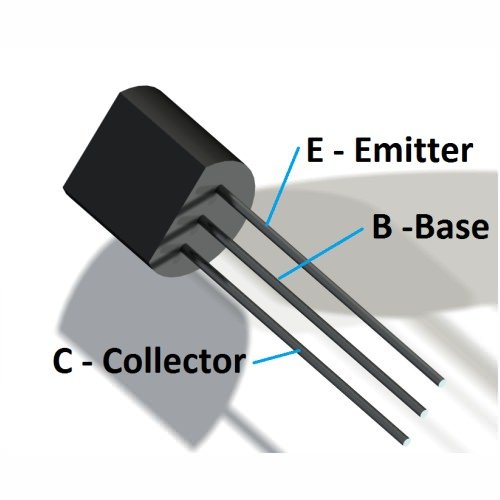- A transistor is a device that regulates current or voltage flow and acts as a switch for electronic signals.
- It is a switching device which amplify the electrical signal likes voltage or current.
- It has three terminals namely emitter, base and collector.

- The base is the middle section which is made up of thin layers. The right part of the diode is called emitter diode and the left part is called collector-base diode.
- There are two types of transistor, namely NPN transistor and PNP transistor.
- The transistor which has two blocks of n-type semiconductor material and one block of P-type semiconductor material is known as NPN transistor.
- Similarly, if the material has one layer of N-type material and two layers of P-type material then it is called PNP transistor.
- The arrow in the symbol indicates the direction of flow of conventional current in the emitter with forward biasing applied to the emitter-base junction.
- The only difference between the NPN and PNP transistor is in the direction of the current.
- It acts as a current control device.
Transistor terminals:
The transistor has three terminals namely, emitter, collector and base.
- Emitter: The section that supplies the large section of majority charge carrier is called emitter. The emitter-base junction injects a large amount of majority charge carrier into the base because it is heavily doped and moderate in size.
- Base: The middle section of the transistor is known as the base. The base forms two circuits, the input circuit with the emitter and the output circuit with the collector. The emitter-base circuit is in forward biased and offered the low resistance to the circuit. The collector-base junction is in reverse bias and offers the higher resistance to the circuit. The base of the transistor is lightly doped and very thin.
- Collector: The section which collects the major portion of the majority charge carrier supplied by the emitter is called a collector. The collector-base junction is always in reverse bias. Its main function is to remove the majority charges from its junction with the base. The collector section of the transistor is moderately doped, but larger in size so that it can collect most of the charge carrier supplied by the emitter.
Working of a transistor:
- while the n-type has a surplus of electrons, the p-type has holes. Normally, the holes in the base acts like a barrier, preventing any significant current flow from the emitter to the collector while the transistor is in its "off" state.
- A transistor works when the electrons and the holes start moving across the two junctions between the n-type and p-type.
- Connect some power to the transistor. We attach a small positive voltage to the base, make the emitter negatively charged, and make the collector positively charged.
- Electrons are pulled from the emitter into the base and then from the base into the collector. And the transistor switches to its "on" state.
- The small current that we turn on at the base makes a big current flow between the emitter and the collector. By turning a small input current into a large output current, the transistor acts like an amplifier.
- When there is no current to the base, little or no current flows between the collector and the emitter. Turn on the base current and a big current flows.
- So the base current switches the whole transistor on and off.
Applications:
- Transistors are the basic building blocks of the integrated circuits and most up-to-date electronics.
- Most common applications of transistor comprise of analog & digital switches, power regulators, multi-vibrators, different signal generators, signal amplifiers & equipment controllers.
- A major application of transistor is the Microprocessors over and over again comprises more than a billion of transistors in every single chip.

Microprocessor contains 42,300




